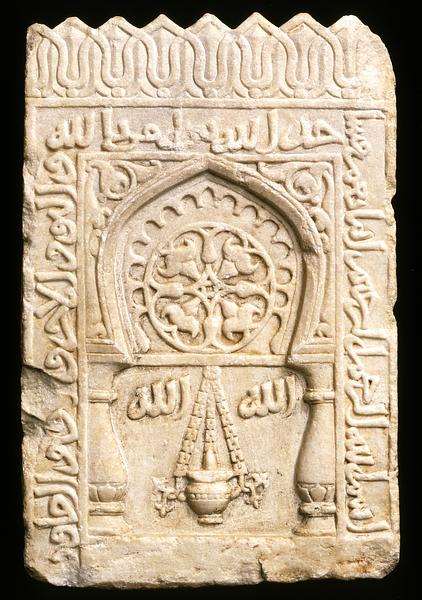Mihrab tile, carved marble
Afghanistan, Ghazna; c. 1100
H: 52; W: 34 cm
This marble tile features a niche with an oil lamp whose burning flame rises high above the lamp’s edge. The name of God, “Allah,” is repeated on each side of the lamp. This motif has a symbolic significance because of the Koran’s sura 24, “the Light Verse.” While God is compared there to the light of the heavens and earth, according to the early Muslim theologians, a burning oil lamp in a niche is a metaphor of Muhammad’s prophetic light.
The marble tile was probably used as a mihrab – the prayer niche in a mosque toward which the devout Muslim turns in prayer.
The sturdy palmettes in the central wheel ornament are a special Ghaznavid variant of the form of decoration that evolved in Abbasid Iraq. The two short columns, in contrast, exhibit the influence of Indian culture.
Inv. no. 74/1979
Published in:
Art from the World of Islam. 8th-18th century, Louisiana, Humlebæk 1987, cat. 46;
Kjeld von Folsach: Islamic art. The David Collection, Copenhagen 1990, cat. 272;
Kjeld von Folsach, Torben Lundbæk and Peder Mortensen (eds.): Sultan, Shah and Great Mughal: the history and culture of the Islamic world, The National Museum, Copenhagen 1996, cat. 24;
Kjeld von Folsach: Art from the World of Islam in The David Collection, Copenhagen 2001, cat. 393;
James W. Allan: “”My father is a sun, and I am the star”: Fatimid symbols in Ayyubid and Mamluk metalwork. The C.L. David Lecture 2000” in Journal of the David Collection, 1, 2003, p. 26, fig. 4;
Sheila S. Blair and Jonathan M. Bloom (eds.): Cosmophilia. Islamic Art from the David Collection, Copenhagen, McMullen Museum of Art, Boston College, Boston 2006, cat. 23;
Catherine B. Asher: Delhi's Qutb complex : the minar, mosque and Mehrauli, Mumbai 2017, fig. 1.12, p. 33;
Joachim Meyer: “Ornament or symbol. Around an early group of silver amulet cases in the David Collection” in Journal of the David Collection, 2021, 5, fig. 8, p. 14;
Joachim Meyer, Rasmus Bech Olsen and Peter Wandel: Beyond words: calligraphy from the World of Islam, The David Collection, Copenhagen 2024, fig. 46, pp. 70-71;
